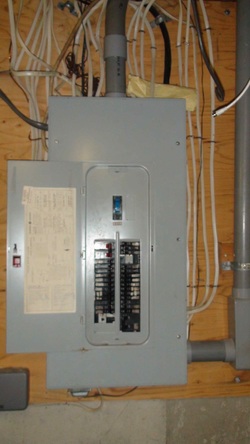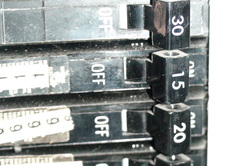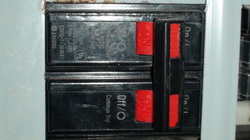Air conditioner troubleshoot: the breaker panel
The following instructions deal with lethal voltages. If you are not comfortable working near these voltages, call a professional.
The breaker panel

If the thermostat is OK, we need to look for power.
There are 2 breakers or fuses associated with the air conditioner. One is for the furnace or indoor unit. Unless the indoor unit is electric, it will have a single breaker.
Breakers are circuit protection that are resettable. They look like switches but will break the circuit if the amperage through the circuit is higher than the number printed on the handle. You will have to find the proper breaker. It may be marked furnace if you are lucky. In most breakers, when it has tripped from over amperage, it will move to the center. To reset, it must be turned all the way off then turned on. Some breakers have a window that shows red if it is tripped.
When resetting, if the breaker immediately pops to the center again, then the circuit has a large overdraw and the short must be found. If it stays on, check to see if the unit comes on. If the unit comes on, you are not necessarily finished. The breaker may trip after a few minutes.
The outdoor unit will have a double breaker because there are 2 poles for 240 volts.
There are 2 breakers or fuses associated with the air conditioner. One is for the furnace or indoor unit. Unless the indoor unit is electric, it will have a single breaker.
Breakers are circuit protection that are resettable. They look like switches but will break the circuit if the amperage through the circuit is higher than the number printed on the handle. You will have to find the proper breaker. It may be marked furnace if you are lucky. In most breakers, when it has tripped from over amperage, it will move to the center. To reset, it must be turned all the way off then turned on. Some breakers have a window that shows red if it is tripped.
When resetting, if the breaker immediately pops to the center again, then the circuit has a large overdraw and the short must be found. If it stays on, check to see if the unit comes on. If the unit comes on, you are not necessarily finished. The breaker may trip after a few minutes.
The outdoor unit will have a double breaker because there are 2 poles for 240 volts.
Resetting the breaker.
If nothing happens when the thermostat is set to call for heat, the breaker for the indoor unit (furnace) may be kicked off.
The breaker for the furnace is usually a dedicated breaker. This means the breaker is used only for the furnace.
The above breakers are in the on position. If they are found to be in the center, they have kicked off due to over amperage or overheat.
Turn the breaker off then back on. If it stays on, and the unit comes on, you may be ok. If your thermostat is electronic, it may have an up to 5 minute delay before the unit comes on. (time it with a watch).
If the indoor unit runs but the outdoor unit does not, check the air conditioner breaker in the panel. It will be a double breaker and should be labeled.
Breakers kick off for a reason. If the breaker kicks off again, the problem will have to be found.
The breaker for the furnace is usually a dedicated breaker. This means the breaker is used only for the furnace.
The above breakers are in the on position. If they are found to be in the center, they have kicked off due to over amperage or overheat.
Turn the breaker off then back on. If it stays on, and the unit comes on, you may be ok. If your thermostat is electronic, it may have an up to 5 minute delay before the unit comes on. (time it with a watch).
If the indoor unit runs but the outdoor unit does not, check the air conditioner breaker in the panel. It will be a double breaker and should be labeled.
Breakers kick off for a reason. If the breaker kicks off again, the problem will have to be found.


